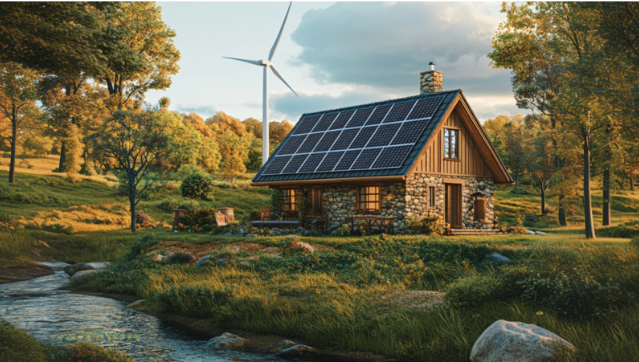Ready to transform your space into a sustainable sanctuary? Embracing eco-friendly homesteading is more than just a trend—it’s a fulfilling journey toward self-sufficiency and a greener future. With every small change, you’re nurturing the land and fostering a lifestyle that respects and revitalizes the planet. So let’s explore how you can start making a difference today using the seven pillars of eco-friendly homesteading.

1. Renewable Energy
The cornerstone of sustainable homesteading lies in embracing renewable energy sources. Solar panels, wind turbines, and micro-hydro systems are powerful tools that can drastically reduce your reliance on fossil fuels. Solar panels provide a clean and inexhaustible power source suitable for most regions. Additionally, wind turbines can add more power to areas with consistent wind patterns, while micro-hydro systems are perfect for flowing water properties. Renewable energy provides power for your activities and significantly reduces your carbon footprint.
Learn more about how solar energy can transform your homestead.
2. Water Conservation Techniques for Eco-Friendly Homesteading
Water is an invaluable resource, and conserving it is key to sustainable living. Rainwater harvesting systems capture and store rainwater for various uses, and ensure nothing goes to waste. Moreover, installing rain barrels or larger cisterns enables efficient water collection from roofs and gutters. Meanwhile, drip irrigation systems in gardens can reduce water usage compared to traditional methods. Furthermore, mulching and choosing drought-tolerant plants help conserve water by retaining soil moisture and requiring less frequent watering.
For additional information on effective water conservation methods, explore this guide by the EPA.
3. Organic Gardening
Organic gardening is truly the heart of eco-friendly homesteading. Avoiding synthetic fertilizers and pesticides helps maintain soil health and promotes biodiversity. Composting kitchen scraps, yard waste, and manure creates nutrient-rich compost that enhances soil fertility. Additionally, crop rotation and companion planting prevent soil depletion and ward off bugs. Plus, introducing beneficial insects like ladybugs and bees also naturally controls pests and supports pollination.
4. Sustainable Building Practices in Eco-Friendly Homesteading
Building and maintaining structures with sustainable materials and techniques is essential for eco-friendly homesteading. For example, using reclaimed wood, bamboo, and recycled materials reduces the environmental impact of construction. Additionally, passive solar design orients buildings to maximize natural light and heat, which boosts energy efficiency. Furthermore, green roofs and vegetation-covered walls improve insulation and mitigate urban heat island effects. Straw bale and cob construction are excellent options for creating energy-efficient, environmentally friendly structures. Sustainable building practices ensure that your homestead is resilient and in harmony with the environment.
For a deeper dive into sustainable architecture, visit Architecture 2030.
5. Waste Reduction and Recycling
Minimizing waste is a core principle of eco-friendly homesteading. A comprehensive recycling program ensures materials like paper, glass, metal, and plastics are reused rather than discarded. Moreover, composting organic waste reduces landfill contributions and produces valuable compost for gardens. Upcycling, or creatively reusing materials to create new items, extends product life and reduces waste. Furthermore, reducing single-use plastics and opting for reusable alternatives, like cloth bags and glass containers, further curbs waste generation.
For more on waste reduction strategies, explore the Zero Waste International Alliance.
6. Biodiversity Enhancement
Enhancing biodiversity is crucial for a resilient ecosystem within eco-friendly homesteading. Planting native species fosters local wildlife and promotes ecological balance. Additionally, creating habitats for birds, insects, and small mammals encourages a diverse range of species to thrive. Pollinator gardens, featuring lavender, sunflowers, and coneflowers, attract bees and butterflies, essential for pollination.
Moreover, establishing ponds or wetlands provides shelter for amphibians and other aquatic life. By boosting biodiversity, you create a dynamic, self-sustaining environment that benefits the land and its inhabitants.
Learn more about enhancing biodiversity from the National Wildlife Federation.
7. Community Engagement in Eco-Friendly Homesteading
Sharing knowledge and resources with others significantly strengthens the sustainability movement. Joining local sustainability groups and attending workshops allows for the exchange of ideas and best practices. Additionally, hosting community events like garden tours or skill-sharing sessions fosters collaboration and mutual support. Educating others about sustainable living practices through blogs, social media, or local classes helps spread awareness. Engaging with your community contributes to a broader network of individuals committed to building a sustainable future together.
For inspiration on community engagement, visit Transition US.
Transform Your Space with Eco-Friendly Homesteading
Embarking on eco-friendly homesteading is about integrating renewable energy, conserving water, practicing organic gardening, building sustainably, reducing waste, enhancing biodiversity, and engaging with your community. Each pillar is vital in creating a resilient, self-sufficient environment that nurtures the land and its inhabitants. By embracing these practices, you can transform your surroundings into a thriving, sustainable haven that contributes to a healthier planet for future generations. Explore our guide on sustainable living practices and take the next step towards a greener future. Sustainable living is about making conscious choices today for a brighter, greener tomorrow.

Leave a Reply